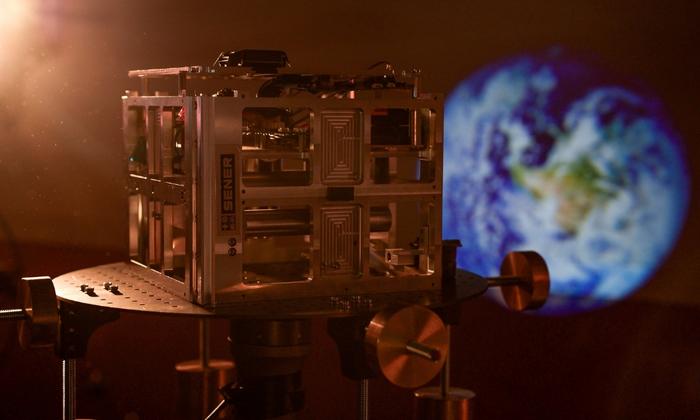Sustainability in space has emerged as a critical concern in recent years, driven by the escalating problem of space debris that threatens the operational safety of satellites and space missions. PERSEI Space, an innovative company with ties to the Universidad Carlos III de Madrid (UC3M), is at the forefront of tackling these challenges. The company has developed groundbreaking technology utilizing space electrodynamic tethers, a method that promises to efficiently mitigate the growing threat of orbital debris while simultaneously enhancing in-orbit satellite services.
PERSEI Space’s inception is notable, as it was nurtured by the European Space Agency (ESA) and backed by the Center for Innovation in Entrepreneurship and Artificial Intelligence (C3N-IA) at UC3M’s Leganés Tecnológico Science Park. The venture also receives vital support from the European Innovation Council, establishing a solid foundation for its ambitious goals regarding space sustainability. This collaborative ecosystem empowers the company to address two pressing issues plaguing the space sector: the removal of space debris and the expansion of in-orbit services such as satellite refueling, repairs, and repositioning, ultimately allowing satellites to complete their intended missions more effectively and safely.
Jesus Manuel Muñoz Tejeda, the CEO and co-founder of PERSEI Space, articulates the dual mission of the company very well. The first challenge is rooted in the physical danger posed by space debris, which, due to its relentless speed, can cause catastrophic damage to operational satellites. When satellites are struck, they can not only be rendered inoperable but can also create smaller debris particles, triggering a chain reaction known as the Kessler syndrome. This phenomenon poses grave consequences for the future of space exploration, making the need for effective removal strategies more crucial than ever.
The core of PERSEI Space’s innovative solution lies in the use of space tethers, a distinctive technology that operates without the need for fuel. This feature alone sets it apart from traditional de-orbiting systems that rely on fuel to execute their tasks. Space tethers can be used not only to lower satellites but also to raise their orbits, showcasing their versatility. This reversible quality, when combined with the ability to scale the technology across a range of satellite sizes, equips PERSEI Space to develop autonomous systems capable of de-orbiting satellites without contributing to the very debris problem they seek to eliminate, even in cases where a satellite becomes non-functional.
The electrodynamic tethers employed by PERSEI Space are made from aluminum ribbons measuring hundreds of meters in length and a few centimeters in width. These ribbons function by interfacing with the ionospheric plasma and the Earth’s magnetic field, producing a force known as the Lorentz force. This effect enables the tether to generate a significant drag force that can help pull satellites down to lower altitudes, facilitating their Deorbiting in an environmentally friendly manner without the burden of extra fuel mass and volume.
A pivotal undertaking for PERSEI Space is the first demonstration mission planned for 2026. This initiative, facilitated by ESA’s Flight Tickets Initiative and backed by the European Commission, is designed to showcase the capabilities of their deorbiting technology. The mission’s equipment will have a weight of approximately 20 kilograms and will incorporate a space tether measuring about 430 meters. Upon reaching orbit, the tether will deploy and commence interactions with the surrounding plasma and magnetic field, generating a drag force that will allow the satellite to deorbit within a few months. This mission is particularly significant, as it has secured funding of €2.5 million from the European Innovation Council and involves collaborations with leading organizations, including SENER Aerospace, the University of Padua, and the Technical University of Dresden.
The timing for such technological advancements could not be more relevant. In response to the increasing threat posed by space debris, new regulations have emerged across Europe and the United States, mandating that satellites cease to remain in orbit for more than five years following the conclusion of their operational missions, a drastic reduction of the previous threshold of 25 years. These new guidelines are critical in managing orbital environments and ensuring that future space endeavors do not contribute further to the existing debris problem.
Furthermore, PERSEI Space has actively participated in ESA’s Zero Space Debris Charter initiative, which aims for a sustainable space environment by the year 2030. This commitment speaks volumes about the company’s dedication to ensuring that their innovations align with broader industry goals towards sustainability and responsible space exploration. Additionally, PERSEI Space is linked to UC3M’s Business Creation and Entrepreneurial Development program, entrenching its role within a supportive academic and entrepreneurial framework that fosters innovation and practical applications of research.
In summary, PERSEI Space is pioneering a transformative approach to the imminent threats posed by space debris and the impending demands for sustainable satellite operations. The development of effective technology, such as electrodynamic tethers, not only seeks to alleviate the problems of the current orbital environment but also paves the way for advancing in-orbit servicing capabilities that can extend satellite lifespans. As we continue to explore and utilize space, the solutions produced by companies like PERSEI Space are crucial stepping stones towards achieving a sustainable cosmic presence that allows for safe and responsible exploration of the final frontier.
#### Subject of Research:
Addressing space debris and in-orbit satellite services.
#### Article Title:
Innovative Technologies for Sustainable Space Operations: The Role of PERSEI Space
#### News Publication Date:
October 2023
#### Web References:
N/A
#### References:
N/A
#### Image Credits:
UC3M
#### Keywords:
Space Sustainability, Space Debris, Electrodynamic Tethers, Satellite Services, Kessler Syndrome, PERSEI Space, In-Orbit Operations, ESA, UC3M, Innovation Council




